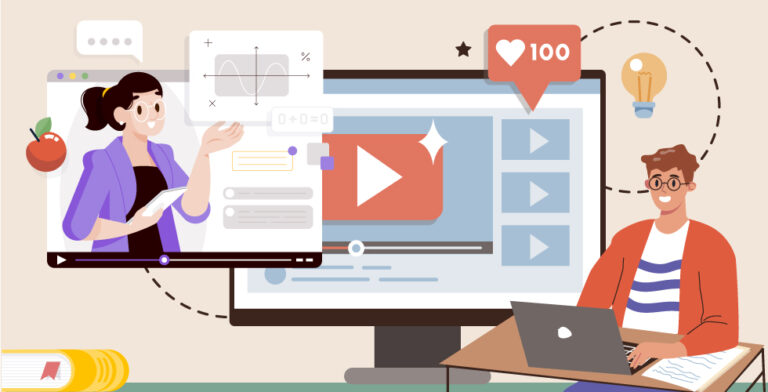Have you ever been to a lengthy meeting and the long slides-reading drained your energy? Imagine you are also in the same place, how will you feel reading through so many slides while the audience is already bored? The best solution to this is something that can fetch the attention of your audience. What can that be? Nowadays with the boom of animation, everything can be expressed through animation. However, what about a video presentation done in animation? Sounds fun, right?
By understanding the power of animation in captivating and retaining audience attention, presenters and communicators can harness this medium to create engaging and memorable presentations that leave a lasting impact. Through the strategic use of animation, clear messaging, effective visual design, storytelling techniques, humor, and interactivity, presenters can maximize audience engagement and retention, unlocking the full potential of their presentations. In this article, we will dig deep into the fact that animation video presentations can enhance engagement and retention among audiences.
Understanding Engagement and Retention
When you are giving a presentation, you definitely don’t want your audience to become drowsy listening to you. To solve this problem, you may try animated video presentations which results in more engagement and retention. But before that what do you understand from engagement and retention?
Engagement refers to the level of involvement, interest, and interaction that an audience has during a presentation. It is the measure of how well the audience is connected to the content being presented. In the context of animation video presentations, engagement plays a vital role in holding the audience’s attention throughout the presentation. Animation has a unique ability to captivate viewers through its visually appealing and dynamic nature. The movement, colors, and storytelling capabilities of animation stimulate the senses and create a sense of excitement, making the presentation more engaging and enjoyable.
Retention on the other hand is the audience’s ability to remember and retain the information presented. It is not enough to engage the audience only; the goal is to leave a bigger impact so that the message sticks with them. Animation video presentations have a distinct advantage in enhancing retention due to their ability to simplify complex ideas and concepts through visual storytelling. Animation breaks information into easily understandable and digestible elements making it easier for the audience to understand and remember key points. Animation has a strong emotional appeal, which can create a deeper connection and increase the likelihood of information retention.
Animation video presentations leverage both engagement and retention by creating an immersive and memorable experience. The combination of visual appeal, storytelling capabilities, emotional connection, and enhanced information processing makes animation a powerful tool for capturing and holding the audience’s attention. The dynamic and interactive nature of animation keeps viewers actively involved, reducing the risk of distraction or disengagement.
Factors Enhancing Engagement and Retention
Let’s break down the factors that enhance engagement and retention:
Cognitive Load Reduction
If you are giving a presentation on a complex physics concept, the idea that can help you is a visual representation of the concept being broken in front of everyone. This is how animation has the power to simplify complex concepts by breaking them down into visual elements and storytelling. Through animated visuals, abstract or intricate ideas can be presented in a more digestible and intuitive manner. By reducing cognitive load, animation helps the audience grasp and understand information more efficiently, leading to increased engagement and retention.
Interactivity
Animation video presentations can incorporate interactive elements, such as clickable buttons, quizzes, or simulations, to actively involve the audience. Interactivity promotes engagement by allowing viewers to participate and respond to the content. By encouraging active involvement and decision-making, interactive animation keeps the audience attentive and interested, enhancing their overall retention of the presented material.
Visual Memory
Visual memory plays a significant role in how effectively information is retained. Animation, with its dynamic and visually appealing nature, has a strong impact on visual memory. When information is presented in animated form, it creates vivid mental images that are more likely to be stored in long-term memory. Visual cues and associations in animation can trigger recall, making it easier for the audience to remember the content long after the presentation.
Attention Retention
Animation has a unique ability to sustain audience focus and attention. The animation’s movement, changes, and visual transitions captivate the viewer’s eyes and maintain their engagement throughout the presentation. By incorporating dynamic elements, such as animated characters, transitions, or effects, animation keeps the audience visually stimulated and prevents boredom or distraction. This sustained attention enhances retention as the audience remains actively involved in the presented content.
Animation Video Presentation for Different Sectors
Animation video presentations can be used in different sectors and industries to effectively communicate information, engage audiences, and enhance visual storytelling. Some of the sectors where animation video presentation can be beneficial are:
Marketing and Advertising
Animation videos can be used to promote products, explain services, and create captivating advertisements. They allow companies to present their offerings in a visually appealing and engaging manner, leaving a lasting impression on potential customers.
Education and E-Learning
Animation videos are excellent tools for educational purposes. They can simplify complex topics, illustrate abstract concepts, and make learning more interactive and enjoyable. Animation videos can be used in schools, online courses, training programs, and instructional materials.

Entertainment and Media
Animation is widely utilized in the entertainment industry, including films, TV shows, and online content. It brings characters and stories to life, creating immersive and visually stunning experiences. Animated presentations can be used for pitches, concept demonstrations, and storytelling in the media sector.
Healthcare and Medical
Animation videos play a significant role in the healthcare sector. They can be used to explain medical procedures, demonstrate the functioning of organs or diseases, and educate patients about healthcare practices. Animation simplifies complex medical information and makes it more accessible to a broader audience.
Technology and Software
Animation videos are commonly used to showcase new software, applications, or technological innovations. They can illustrate how a product works, highlight its features, and demonstrate user interactions. Animation helps convey technical information in a visually engaging and user-friendly manner.
Nonprofit and Social Causes
Animation videos are powerful tools for raising awareness and advocating for social causes. They can effectively communicate messages, evoke emotions, and inspire action. Animation can be used by nonprofit organizations to educate the public, promote campaigns, and convey impactful stories.
Corporate Communications
Animation videos are valuable for internal and external corporate communications. They can be used to deliver company updates, explain processes, present data, and statistics, or introduce new initiatives. Animation videos make complex corporate information more engaging and accessible to stakeholders.
How Animation Video Presentation Can Be Made?
Animation videos can be created through a multi-step process that involves concept development, storyboarding, character design, animation production, and post-production. The process typically starts with outlining the concept and script, followed by creating a visual storyboard to plan the sequence of scenes. Character design and animation production involve creating and animating characters, backgrounds, and objects using specialized software. Post-production includes adding sound effects, voiceovers, and music, and finalizing the video through editing and rendering. The process requires a combination of artistic skills, technical expertise, and creativity to bring the animated world to life and produce high-quality animation videos.
Animation Video Presentation Here to Stay?
As we can see, animation video presentations have a proven ability to enhance engagement and retention among audiences. Through visually captivating and immersive experiences, animation simplifies complex concepts, stimulates visual memory, and promotes active participation. By strategically incorporating clear messaging, effective visual design, and interactive elements, animation videos create lasting impressions and memorable experiences for the audience. With ongoing advancements in technology and animation techniques, animation video presentations will continue to be a valuable tool for effective communication across various sectors and industries.






